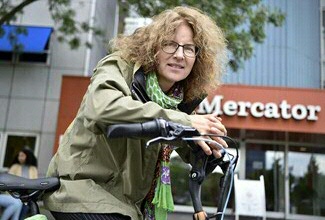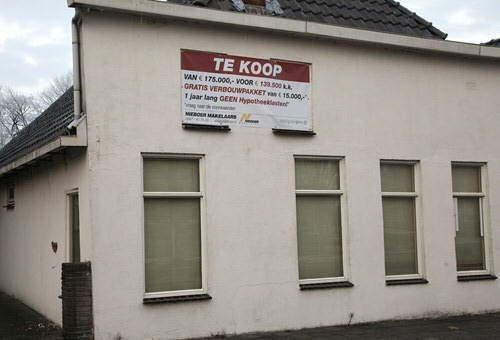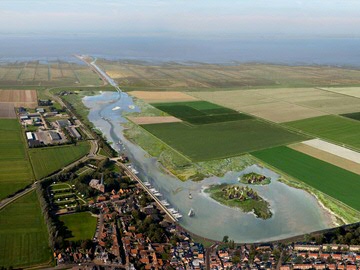De strijd tegen krimp

Op de e-bike vanuit Eenrum komt ze, Tialda Haartsen. ‘Ik heb een tijd in de stad gewoond, maar het platteland blijft toch trekken. En Eenrum is een levendig dorp met voldoende voorzieningen.’ Haartsen kan het weten. Als onderzoeker van krimp op het platteland heeft ze voldoende vergelijkingsmateriaal. In het moeras van krimp ziet ze soms onverwachte mooie bloemen opbloeien.
Tekst: Martin Althof, afd. Communicatie / foto: Elmer Spaargaren
Veel mensen, vooral jongeren, trekken weg uit de dorpen op het platteland. Werkgelegenheid is er nauwelijks en de supermarkt en de school verdwijnen. Haartsen: ‘Krimp gaat altijd over verlies en heeft een negatief imago. Maar soms komen er in die omstandigheden ook nieuwe en verrassende initiatieven tot stand, zoals het project ‘Holwerd aan Zee’. Een grootschalige ingreep in het landschap zorgt daar voor nieuwe levendigheid in een krimpdorp.’
Achterblijvers geen ‘losers’
Het beeld bestaat dat vrijwel alle jongeren uit de dorpen in de krimpgebieden wegtrekken en dat alleen de kansarmen, de ‘losers’ achterblijven. Dat blijkt genuanceerder te liggen. Haartsen licht toe: ‘Natuurlijk trekt een deel weg, in ieder geval tijdelijk, om een opleiding te gaan volgen. Maar dat was altijd al zo. Zo’n 60 tot 70% van de jongeren blijft in het dorp. Dat is veel meer dan de meeste mensen denken. De band van de inwoners met de plek waar ze zijn geboren en zijn opgegroeid is sterk. Ze zijn vaak niet van plan te vertrekken.’

Afstand en bereikbaarheid
Achterblijvende geboortecijfers en een negatief migratiesaldo zorgen ontegenzeggelijk in veel dorpen voor krimp en verdwijnende voorzieningen. De economische situatie en veranderend consumentengedrag spelen daarbij ook een rol. Met het Kenniscentrum Krimp Noord-Nederland probeert Haartsen kennis te delen en oplossingen te vinden. Haartsen: ‘Afstand en bereikbaarheid zijn essentieel. Snel internet heeft daarin al veel goed gedaan. Maar ook de verbetering van wegen en spoorwegen biedt kansen. Veel snellere (elektrische) fietsen maken sommige dorpen aantrekkelijker om te wonen. Zaak is wel dat de infrastructuur voortvarend wordt aangepakt. Na reconstructie van de autoweg tussen Eenrum en Groningen keerden de smalle fietspaden gewoon in de oude vorm terug, met boomwortels. Echt een gemiste kans!’
Opschuivende grenzen
Welke dorpen in welke gebieden zijn gevoelig voor krimp? Welke dorpen weten hun inwonersaantal en voorzieningen op peil te houden? Gebieden binnen de invloedssfeer van een stad doen het vaak beter dan de verder weg gelegen dorpen. Maar door betere verbindingen schuiven de grenzen wel langzaam op. Haartsen: ‘Voor probleemgebieden moet je op zoek naar andere oplossingen. Denk bijvoorbeeld aan het intensiever betrekken van het bedrijfsleven bij het onderwijs. Jonge mensen kunnen met een stage snuffelen aan het werk dat de regio biedt. Daar zijn in Oost-Groningen goede ervaringen mee opgedaan. Soms kunnen deze gebieden ook gebruikmaken van de kennis, kunde en geld van hen die ooit uit het gebied zijn vertrokken. De band met de geboortegrond blijft immers altijd bestaan. Zo houden enkele hoogleraren afkomstig uit Oude Pekela zich actief bezig met de toekomst van dat gebied.’
Het duurt te lang
Net als veel Groningers maakt Haartsen zich erg boos over de situatie in het aardbevingsgebied en over de reactie van de overheid: ‘Dit gebied had het al niet gemakkelijk, en daar komen de aardbevingen nog eens bij. Je kunt niet zomaar tegen mensen zeggen dat ze maar ergens anders naar toe moeten gaan. Mensen zijn geworteld in dat gebied, hebben daar alles. De gedupeerden houden het nauwelijks vol, het is te ingewikkeld.’ Haartsen stelt vast dat er in Nederland wel sprake van een zekere solidariteit met de mensen in het Groningse aardbevingsgebied: ‘Maar je ziet die solidariteit sterk afnemen met de afstand tot het gebied en met de tijd. Het duurt simpelweg te lang.’

Het heft in eigen hand
Ronduit enthousiast wordt Haartsen van het initiatief van vier mannen uit Holwerd in Noord-Friesland. Zij stellen voor de dijk bij hun terpdorp door te breken om zo het dorp weer met de zee te verbinden: Holwerd aan Zee. Ze schreef erover in een blog op de website van de RUG: “In Holwerd aan Zee is de nieuwe Lely opgestaan”. ‘Ik vind het een fantastisch idee, het biedt perspectief aan het krimpende Holwerd, het is visionair, door betrokken burgers zelf bedacht en deels ook al zelf gefinancierd. En het sluit aan bij discussies in de planologie om niet meer tégen het water te strijden, maar om de zee gecontroleerd toe te laten. Ik daag de Rijksoverheid uit om dit initiatief te omarmen en te financieren. Dit soort gedurfde investeringen is nodig in de eenentwintigste eeuw, zeker ook in Noord-Nederland!’
Zie ook de documentaire van Kees Vlaanderen over Holwerd aan Zee
Meer informatie
Meer nieuws
-
01 december 2025
De kracht van beweging
-
24 november 2025
RUG en Ministerie van I&W starten brede meerjarige samenwerking
